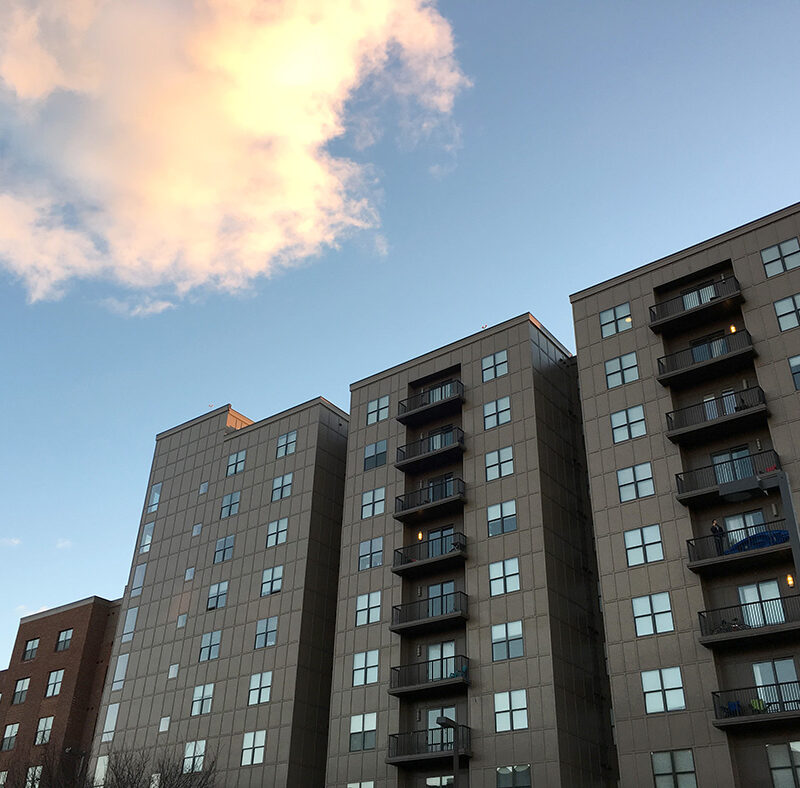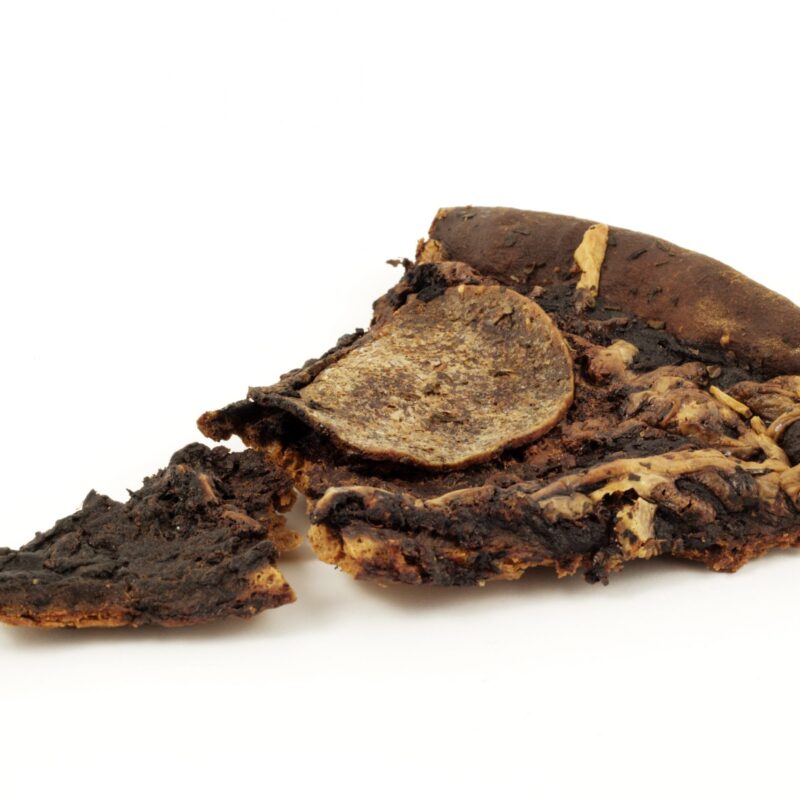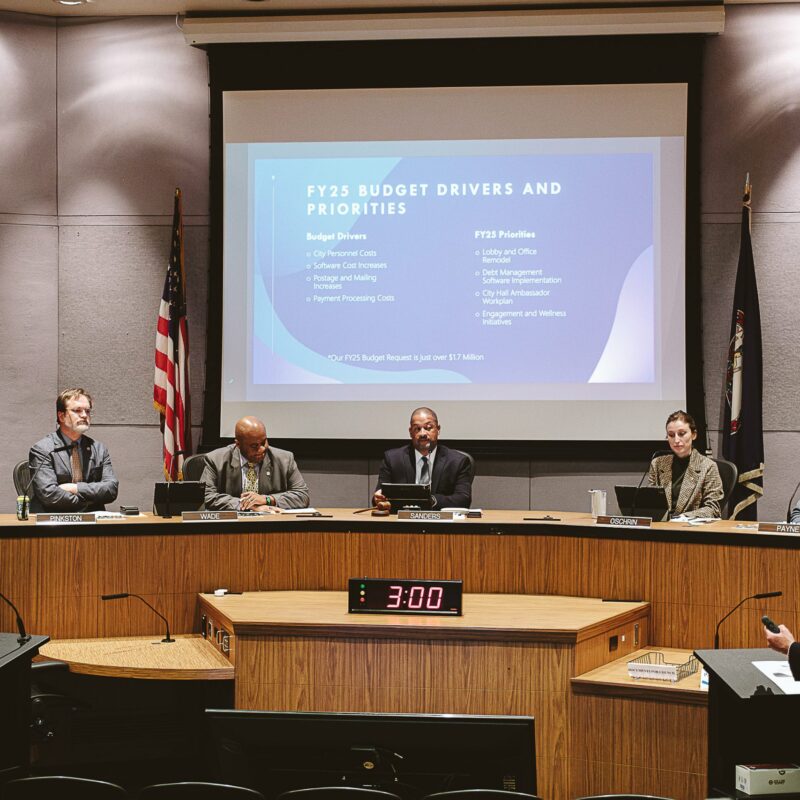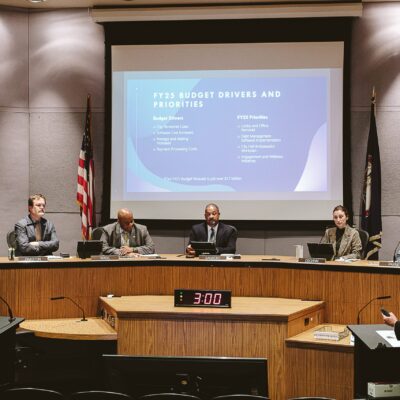When former UVA President Robert M. O’Neil met in Madison Hall with the man who took his job 20 years ago, the controversy of the moment—and when you’re a university president, there is always a controversy of the moment—was a typically rogue pronouncement by Attorney General Ken Cuccinelli. He had effectively told state higher ed officials that they had no legal right to protect gay and lesbian employees from discrimination. That was on March 15. Neither John Casteen nor O’Neil could have predicted the headline-grabbing tragedy that would beset the campus some seven weeks later. Fortunately, most of the work of heading a major university is of a comparatively managerial nature, and rarely involves police reports and CNN. Such was the business that O’Neil and Casteen discussed on that Monday afternoon in an office appointed with sailing regalia and a life-size cut-out of Jimmy Buffett, who had recently played the John Paul Jones Arena. O’Neil, who now directs the Thomas Jefferson Center for the Protection of Free Expression, and Casteen, who will address the graduating class this Sunday and will officially retire on August 1, evince mutual respect and quiet collegiality. In many ways, Casteen’s UVA is an entirely different institution to what it was in O’Neil’s day, and that’s where O’Neil started the one-hour conversation.
•
|
Two decades of major change Highlights from John Casteen’s 20-year reign at UVA
March 1990 The Board of Visitors announces that John Casteen III will be the seventh president of UVA.
January 1991 UVA adds “sexual orientation” to its nondiscrimination policy.
May 1992 Tina Fey, future head writer for “Saturday Night Live” and creator of “30 Rock,” graduates from UVA.
June 1995 Two girls born at UVA Hospital are switched and given to different mothers. The mistake first comes to light some three years later.
June 1997 Carl Smith (right) donates $25 million to renovate Scott Stadium. In addition to football, the expanded stadium will host major rock shows, starting with Dave Matthews Band in 2001.
October 1998 Seven winners of the Nobel Peace Prize, including Archbishop Desmond Tutu and the Dalai Lama, visit UVA.
August 1998 U.S. News & World Report ranks UVA the best public university in the country. It has battled with UC-Berkeley for the top spot ever since.
August 1999 A lengthy profile of Casteen appears in The New York Times. The article begins: “If ever there were a man placed on this earth for the purpose of being president of the University of Virginia…”
May 2001 Physics professor Lou Bloomfield discovers the mother lode of potential Honor Code violations when a computer program turns up 122 suspected instances of plagiarism among student papers in his introductory class.
January 2003 Casteen apologizes to the state of West Virginia after the UVA pep band depicts a WVU student in pigtails and overalls. That act ushers in the age of the University Marching Band.
July 2005 At UVA’s urging, the state passes the Restructuring Act, also known as “charter,” which Casteen says will “carry Jefferson’s early vision of the university forward.” The school gets to set its own tuition and manage its human resources system.
July 2005 Casteen calls for designs for a “center for the arts” to be built at the intersection of Ivy Road and Emmet Street. Following news that the president plans to retire, the area gets dubbed the John and Betsy Casteen Arts Grounds.
November 2005 Staff member Dena Bowers, a critic of the school’s restructuring, is fired as a result of using her work computer to send e-mails that assail UVA to colleagues. Eight months later, Bowers sues UVA for $1 million for wrongful termination.
February 2006 UVA launches Access UVA, a financial aid program that meets 100 percent of need for low-income undergraduates through a combination of grants and loans.
April 2006 Seventeen UVA students are arrested after a four-day sit-in in Madison Hall, where they demanded Casteen raise the base wage to $10.72 an hour.
August 2006 John Paul Jones Arena opens, and attracts acts from Bob Dylan and Taylor Swift to Jay-Z.
September 2006 Joining the ranks of Harvard and Princeton, UVA drops its early-decision admission program.
September 2006 The Campaign for the University of Virginia, the largest fundraising effort to date, launches with the goal of raising $3 billion. By 2009, the campaign reaches $2 billion.
April 2007 Retired Landmark Communications CEO Frank Batten, Sr. donates $100 million to UVA to create the Frank Batten School of Leadership and Public Policy.
June 2008 Women’s basketball powerhouse Debbie Ryan, who has led the UVA team since 1977, is inducted into the Women’s Basketball Hall of Fame.
January 2009 Only 2 percent of UVA staff switch from the state-run human resources system to a new plan managed directly by the university.
October 2009 Virginia Tech student Morgan Harrington goes missing after a Metallica concert at the John Paul Jones Arena. Three months later, her remains are found on an Albemarle County farm.
November 2009 UVA fires head football coach Al Groh after nine seasons, sending him off with a severance deal—$4.3 million—that exceeds what most people earn in a lifetime of working.
January 2010 The Board of Visitors announces that Teresa Sullivan will be UVA’s eighth president, and the first woman to hold the position.
May 3, 2010 Fourth-year student and lacrosse player Yeardley Love is found slain in her bed. Two days later, a visibly distraught Casteen addresses the UVA community at a candlelight vigil. “Don’t hear a scream…and keep quiet,” he said. “Speak out.” |
Robert O’Neil: I’m just astounded by how much has transpired in these 20 years. When I arrived in 1985, the essentially first capital campaign was about to conclude, initially at $90 million, which ultimately wound up at $147 million. You do that now in a week or so, I guess. But what a struggle to get to $90 million and then to build on that to $147 million at a time when it was not even clear that a viable capital campaign could be achieved. And of the changes that have occurred from that time to this, I don’t think there’s any that’s more striking than the level of private support that you have garnered in these 20-plus years.
John Casteen: I worked a little bit on that first campaign at the very beginning. And one of the things I remember [President] Frank Hereford dealing with was that there was really no choice, given the priorities that he wanted to see financed that could not be financed by the state. And Frank was always, as you know, greatly concerned about keeping tuition under control. He was president during the period when the state and the federal government were both backing away from the commitments to student financial aid. And I think he saw the capital campaign as a moment of real hope. He sort of set his foot in a certain direction and he was going to take us there. I always admired him for this. He was a very unassuming and low-key man who set very large goals and simply achieved them one step at a time
O’Neil: I recall two statistics, which are classically paradoxical. That, on one hand, between about 1982 or ’83 and the late 80s the average full professor salary went from the top of the bottom third of AAU rankings to the bottom of the top third. I’m not quite sure how that happened, but that’s the sort of upside. The downside is something that I don’t think we realized for a couple of years. And that is that, among all AAU institutions that had medical schools, UVA’s sponsored research levels were next to the bottom, above only that of the University of Missouri-Columbia. That really scared me when I realized just how far behind we were both in levels of sponsored research and even more in terms of usable research facilities.
Casteen: I think about that whole issue—inadequate facilities for science. I can walk around behind the hospital and say, Yes, we’ve made progress, but by comparison to what has been done in the same period at Chapel Hill or at Michigan—at places that we really ought to see as our competitors as well as our partners. But other than the Carter Harrison Research Building behind the Medical School that is privately financed, and those two families, we haven’t found donors willing to pay for major facilities for the sciences. Until we got the restructuring legislation in 2005, we didn’t have the capacity to issue the kind of institutional bond of debt that’s letting us build the two large facilities that are being built, happily, in the football parking lot. There’s something symbolic and important about saying that, at this point, athletics will step back a little bit and we’ll begin to fill in some of the blank spots in the academic plant.
I think it took us a long time to accept the idea that large science buildings are necessary. Scale is part of it. We had a terrible time dealing with the reality that science buildings are, in the end, built to industrial specifications and not more academic specifications.
O’Neil: One of the other things of which I take note is how far behind we were in both the creative and performing arts. There, as you know, we really struggled. And I think we got some modest achievement, but there was such a long way to go. This was just not an institution that valued and proclaimed the creative and performing arts as you now do.
Casteen: I hope we’ve established that as part of the culture. My concern about that was partly that in the years when I was teaching at Berkeley I was living in a place with a very different set of values. And where performers, whether it was an outside group—Alvin Ailey’s dancers were in residence at Berkeley when I was there—or an inside performance, we’d fill the hall. During those years when I would come here as a visiting professor, for a while I couldn’t figure out what it was that was missing. But what was missing was the vitality that the arts bring.
I’ve got a theory, by the way, about why this place was so slow to embrace the arts. And that is that the culture of the boys school stayed with us a lot longer than the reality of the boys school did. I wouldn’t say that Princeton or Yale or Harvard necessarily used every resource that was generated by coeducation, but they did a lot better job of seeing coeducation as a source of assets to be used to build the university’s plan for design than we did. I think maybe if we had done a different kind of planning in the late ’60s before the coeducation occurred, the adoption of a fine and performing arts as sort of the common property of the university might have come soon.
O’Neil: One of the other things that I’ve struggled with is the internationalization of this institution. I was always haunted by the fact that Mr. Jefferson, before his death, actually admitted the first international student. But it didn’t go very far. And 150-some years later, in a way, we’re still looking for the international student. As a relatively small institution, it’s very hard to do, say, what we were doing at Madison.
Casteen: Bob, you’ve raised two issues there. One is the relatively small institution. I’m convinced that for this university to be first-rate in the next generation, it has to be far larger.
The international piece: I understand the legal situation, that is, as long as we are so small we cannot provide admission for enough Virginia students to satisfy the state’s voters. As long as that’s the situation, I’m going to have problems. But one way to solve the problem is to stop thinking in terms of ratios and instead think in terms of how many Virginia students are we, in fact, accommodating. The state at the moment is something like 40,000 seats short in terms of the ability to accommodate its own students who want to go to college. The new governor believes that the shortage by the end of his term is going to be about 100,000 seats.
The foreign student falls between the schools, and the international student is simply out of state. And as long as we are too small to accommodate the in-state demand, the international student is a casualty. What we’ve been able to do is go from about 500 international students to about 2,000. So something like 8 percent, 8½ percent international students. That’s not in the enlightened self-interest of the U.S.
National policy ought to say that we seek students from everywhere and that we seek to put a kind of American brand on a sensible value system, a belief in the worth of a man and what it says about a democratic culture and so on. That we seek to make that one of America’s products. … I’ve really agonized the last five years over how poorly America has addressed Africa. In our time, American universities ought to be loaded with African students who would find here a place to learn, to develop skills, to mature, that they can’t find in Africa. But even the EU, which does a better job than America does in confronting African issues, even the EU is behind in that sort of thing.
|
In order to increase the number of international students at UVA, Casteen says that the school needs to boost its number of in-state students, as well as the size of the university: “National policy ought to say that we seek students from everywhere and that we seek to put a kind of American brand on a sensible value system.” |
At some point, the system of education has got to be able to support indigenous leaders who have the scientific expertise and the political savvy and so on to make good things happen.
I look at what has happened in China and I am baffled. Any number of other non-American universities is operating genuine campuses in China. U.S. institutions are offering basically study centers. We’ve established our first permanent foothold in China at Peking University, which is the ideal place to establish it. But if Nottingham can be in Burma and Thailand and China and so on, it says something about the difference in the British view.
O’Neil: Why has there not been more emphasis on international area studies programs as such?
Casteen: The one that I’ve looked at the most is the off-and-on center that looks at Russian culture. The reason given is that a grant application was not funded. The reality is that the university, which is probably to say the college, saw other things as being more important. And therefore did not pursue that. It’s an oddity as a president when you learn about such things as the collapse of the center two or three years after it happened. And trying to restore it is much harder than establishing it in the first place.
O’Neil: Oh, I recall there were severe repercussions, even of which I was aware. I think I was mercifully spared most of the details of which you are now painfully aware. But I knew there were problems.
Casteen: Yeah, lots of anger, a lot of assigning the blame to various people and no serious strategy to sustain it. I don’t think that in that particular case it reflects, let’s say, xenophobia on the part of the university. I think it’s more a reflection of the overstressed budget in the college and the lack of the kind of resources that I hope over time will be found. But we don’t have them now to provide bridge funding.
O’Neil: And again so much has happened and you’ve gone so much further. These were hopes that I had initially but a lot has been realized. Two areas that I’ve been fascinated with and would just like to catch up on. One is the honor system. I would’ve said a year or two after I left office that the honor system would be gone. But apparently, it doesn’t thrive, but at least it functions.
Casteen: I think it may actually thrive. The fact that the students continue to have periodic referenda and to argue out their basic principles encourages me. It’s always struck me that the debate about the honor system is off point, going back to the time when I was a student. So going back almost 50 years. The debate has always seemed to be about the single sanction. It’s probably the least important aspect of the system. It’s a system of self-governance; it’s a system of teaching people to be responsible for their own communities. And the constant haggling over the penalty sort of gets away from other basic principles that probably ought to be articulated and attacked and defended.
I think most people here, most alumni, are aware that it’s the only system of its kind in the country. That even West Point or VMI, that the students are less free to govern themselves in those systems. What’s always impressed me is that faculty members do in fact tolerate a system that’s so different from what essentially everyone else grew up with. I don’t hear from a lot of college presidents or heads of schools that are looking at honor systems, but as I’m sure happened when you were president, I have heard from some. And the thing that they stumble over is whether you can trust students to govern themselves. I’ve seen only two cases that I would describe as matters of egregious wrong in the 20 years. And one case the general faculty corrected it and the other case the director of the Visitors Board did.
O’Neil: One other area of community that I know you’ve struggled with and I guess we’ve both struggled with and that is the Greek system. Their dramatic exposure, if you happen to live on the downside of a hill—this was a real challenge, and we finally worked with the IFC and the ISC, we put together an advisory committee of the alumni officers and so on. And I guess I would have anticipated sometime within the past 5-10, if not 20, years a much more dramatic confrontation between the Greek community and the rest of the community than clearly has occurred.
Casteen: In truth while the newspapers at the time did not understand what was going on, but early in my presidency that confrontation did occur.
I think right then I saw it as a do-or-die confrontation, so I dealt with it that way. Oddly enough, we’ve had no confrontations of that kind with the sororities. And that’s not to say that behavior that might be objectionable does not occur there, it’s simply that for some reason it does not surface here. Betsy has two daughters and when we were married I suddenly had two daughters who were, in their years as students, members of a sorority—the same one. I have to say that I admire what that sorority provided for them as young women growing into independence: a thoughtfully conceived and well-run organization. The net of that, after their four years in that sorority, was that they emerged as fully formed women with the experience of a culture in which one ran the culture in the sorority. And they moved very successfully into what they did next. But, yeah, I would’ve thought that there would be much more trouble over the years than there has been.
There have been issues over the years; fraternities come and they go. The alumni advisory system has worked. I remember sitting on a plane next to a man, a classmate of mine, who told me one of the fraternities over on this side of Madison Bowl was about to close because they were not satisfied that it was being properly run by the students. Within a month or so it did close. Two years later it reopened and they went about their business. Again maybe self-government really does work if people understand that their actions have consequences.
|
Of the changes that have occurred since Casteen succeeded O’Neil in UVA’s top job, there’s none “more striking,” says O’Neil, than the level of private fundraising that the university has undertaken. The current capital campaign has a $3 billion goal. In O’Neil’s day, the big figure was $147 million. |
You know, Bob, something that I have thought about a lot is the service fraternities and sororities that meet an interest that African-American students feel. By and large, parents of African-American students who talk to me about those organizations encourage me not to help them when they try to become residential organizations. Parents seem to want their daughters and sons mixed up in the general population. But I wonder if the ultimate challenge to the system is going to be finding a way to mirror the university for what it really is—almost a third of the student body now is in some sense minority. And yet very, very few are accommodated within that system.
O’Neil: I was just going to end with a sort of open-ended question about our successor.
Casteen: I’m very optimistic. I think that the university has reached a stage of maturity where whatever hostility to an outsider or whatever might happen, is not going to happen. I think by and large people recognize the need for orderly change. I find her very engaging, and rather than talking a great deal, we exchange notes regularly. And she hasn’t asked for my advice and I haven’t offered my advice. Very, very quick, very thoughtful of the academic nature of the enterprise. And she also has an unusual depth of experience and an understanding of the management of the enterprise. She sees, I think, the relationship between the academic outcome and the managerial system that lies under it.
O’Neil: I just have one perspective about Terry. I had an urgent need to develop a new policy, happened to be with the University of Michigan—and I’ll spare the details—and I didn’t know how it was going to come out. I got a report through the Senate Assembly in Ann Arbor in which I learned that Terry had done exactly what I had hoped and had actually established the policy very quietly in the Provost’s Handbook. I could not have been happier if I’d lobbied for it, she just did it. I read it and I marveled. I said, “That’s class.”
Casteen: Let me in a sense misuse what you just said. I am struck by how frequently doing right quietly turns out to be the most effective thing to do. This focus in Virginia in the last 10 days with anti-discrimination rules having to do with sexual orientation—I very quietly put those into the administration regulation rules in our catalogue in 1993. No talk, nothing. And the place has lived by the rule for 17 years, and it will for as long as I’m here and I suspect a lot longer.
This is sort of off the point but I am optimistic at this point that these upheavals of the last several days in Virginia may lead to either a state or a federal law that provides the protections that the 14th amendment implies. I’ve begun to hear from members of Congress saying we’re going to fix this. People that have not been involved in the dispute before. Maybe that’s quietly doing good, too.
O’Neil: Oh absolutely, it is both quiet and good, a note on which probably we should conclude.
Casteen: This has been fun, you’re very generous to come talk to me.







